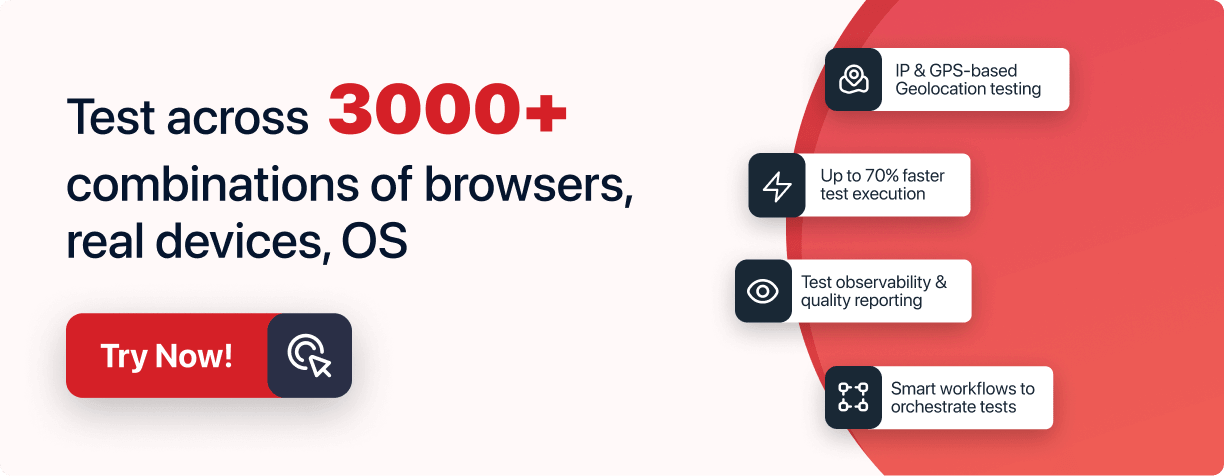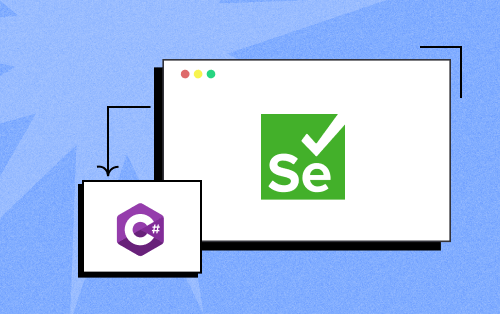- Automation
- Home
- /
- Learning Hub
- /
- Software Quality Assurance
- -
- May 06 2024
What is Software Quality Assurance
Learn essential concepts, and techniques, for high-quality software through effective Software Quality Assurance, covering importance, benefits, and more.
Total Chapters (8)
Chapter 2 : What is Software Quality Assurance and Why is it important?
OVERVIEW
Software Quality Assurance (SQA) is a systematic process that ensures the quality and reliability of software products by monitoring the software engineering processes and methods used to ensure quality. This practice encompasses the entire software development lifecycle, from requirements gathering to coding, testing, and release.
The primary goals of SQA are to prevent defects, ensure that the software meets specified requirements and standards, and improve the development and maintenance processes through systematic activities. In line with this need for robust quality practices, a recent poll on social media shows that the majority of QA professionals prefer to update their strategies quarterly.
As seen in the poll results, 53% of respondents advocate for quarterly reviews and updates of QA strategies, highlighting the industry’s recognition of the fast pace of technological advancements. This preference for quarterly assessments aligns with agile practices, demonstrating a commitment to staying proactive and adaptive.
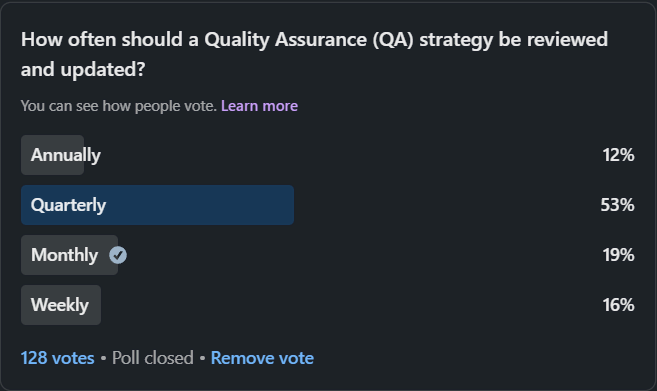
Beyond ensuring the functionality and security of the software, Software Quality Assurance (SQA) takes an additional stride to increase the user's satisfaction and confidence in the software.
This tutorial covers the essential role of SQA, not only how it will take place but also how it helps build high-class, dependable applications.
What is Quality Assurance Software Testing?
Software Quality Assurance is a set of systematic activities providing evidence that a software product has been developed in compliance with the required specifications during the planning and development phases. SQA covers the whole of the software development process, including requirements definition, software design, coding, source code control, code reviews, configuration management, testing, release management, and product integration.
From software inception to software development to its retirement, one of the objectives this plan should guide is quality while ensuring that problems and defects are prevented and anticipated throughout. Robust SQA practices lead to the release of superior products, enhancing customer satisfaction and trust. This can result in increased market share and profitability.
Additionally, by minimizing defects and maintaining high performance and security standards, companies reduce costs related to post-release patches and fixes. This not only saves direct costs but also bolsters the brand's reputation, fosters customer loyalty, and promotes long-term financial health.
What is Quality Assurance in Software Development?
Software Quality Assurance (SQA) aims at defect prevention throughout the entire Software Development Life Cycle (SDLC) so that developed software meets extremely high-quality criteria. The strong incorporation of the respective processes, activities, and techniques with SQA in every phase of SDLC elevates software reliability and customer satisfaction.
It includes the production of working software whose functionality is not only characteristic of satisfying the needs of the users but also reliable, easily maintainable, and easily scalable.
Role of SQA Across the SDLC Phases:
- Gathering: SQA professionals and stakeholders work together to gather needs that must be clear, realistic, and revisable to avoid pitfalls.
- Design: At this point, SQA reviews system designs for requirement compliance and possible risks or failures.
- Development: In addition, SQA has high standards of coding, including enforcing coding standards, carrying out reviews of the code, and running unit tests for early issue catching and best practices.
- Testing: Comprehensive test plans and scripts are developed to run across multiple testing phases (functional, integration, system, performance) to verify that the software satisfies all requirements.
- Deployment: SQA should look into software stability and documentation before deploying it, which means the deployment process has no hiccups that may occur.
- Maintenance: SQA monitors the software's performance, corrects defects reported by users, and executes regression testing to verify that changes or fixes are not introducing new problems during the maintenance phase.
What Does Software Quality Assurance (SQA) Encompasses
Software Quality Assurance (SQA) includes all the phases from the initial design to deployment so that every part of the software development is reviewed and tested to ensure quality.
- Purposefulness: Planning and Documentation: Establishing quality objectives and documentation for consistency.
- Process Monitoring: Checks up on the development processes and how to improve them.
- Design Control: In this phase, the design of the software ensures quality standards are met.
- Code Reviews: Finding bugs and ensuring adherence to standards.
- Testing: Conduct testing through unit testing, integration testing, system testing, and acceptance testing.
- Configuration Management: Control of changes to preserve software integrity.
- Release Management: It's a process to ensure the quality of the release.
- User Feedback: We welcome user feedback to enable us to continue improving our performance.
These are the main points of essential activities in Software Quality Assurance (SQA) to create high-quality software.
Why is Software Quality Assurance Important?
Software Quality Assurance (SQA) is important because it ensures:
- Error Reduction: SQA identifies and rectifies errors early in the development cycle, significantly reducing the cost and impact of fixing bugs after release.
- User Satisfaction: By ensuring that software meets functional and technical specifications, SQA enhances user satisfaction through stable and seamless performance.
- Regulatory Compliance: SQA helps organizations adhere to industry standards and regulations, reducing legal and financial risks.
- Security: Through thorough testing, SQA minimizes security vulnerabilities, protecting both users and organizations from potential breaches.
- Cost Efficiency: Addressing issues during the development phase rather than after deployment saves significant resources and time.
- Trust and Reliability: In critical industries like healthcare and finance, SQA ensures that software is reliable and safe, maintaining trust in digital systems.
- Innovation Support: By managing risk effectively, SQA allows companies to innovate more confidently, pushing boundaries without compromising on quality or safety.
- Brand Image: Effective SQA practices enhance a company’s reputation for quality, attracting and retaining customers while differentiating the brand in competitive markets.
- Market Expansion: Reliable software can expand market reach by meeting diverse customer needs and complying with international standards, opening up global markets.
- Long-term Profitability: By improving product quality and customer satisfaction, SQA contributes to increased sales and customer loyalty, driving long-term profitability.
- Scalability: SQA frameworks support scalability by ensuring that software can handle increased loads and functionality expansions without performance degradation.
SQA is crucial for delivering high-quality software that meets user needs, complies with standards, and drives success in the competitive market.
How to Implement Software Quality Assurance?
Implementing Software Quality Assurance (SQA) effectively involves setting up a comprehensive system that oversees every phase of software development to ensure quality standards are met. Here are key steps to implement SQA in a project:
- Define Quality Goals and Objectives
- Develop an SQA Plan
- Roles and responsibilities: Assigning team members to specific quality assurance roles.
- Standards and procedures: Defining coding standards, review practices, and documentation standards.
- Tools and resources: Identifying tools for tracking defects, automating tests, and managing documentation.
- Establish Quality Metrics
- Conduct Formal Technical Reviews
- Implement Testing Strategies
- Unit testing: Testing individual components for correctness.
- Integration testing: Ensuring that software components function together correctly.
- System testing: Verifying that the system meets all specified requirements.
- Acceptance testing: Conducting tests to ensure the system is ready for production.
- Ensure Compliance with Standards
- Use Automation Where Possible
- Train and Develop Skills
- Continuous Process Improvement
- Risk Management
Start by clearly defining what quality means for your specific project. Set specific, measurable, achievable, relevant, and time-bound (SMART) goals that align with the business objectives and customer requirements.
Create an SQA plan that outlines how quality will be assured throughout the project. This plan should include:
Define metrics to measure the effectiveness of the SQA process. These could include defect density, code coverage by tests, customer issue incidents, etc. These metrics will help monitor the progress and effectiveness of quality assurance activities.
Implement peer reviews and inspections at various stages of the development process to catch defects early. Reviews can be applied to requirements, design documents, code, and test plans.
Develop a comprehensive testing strategy that covers the following:
Here is a detailed blog that will help you plan a successful quality assurance (QA) strategy and help you with the critical components of a QA strategy.
Throughout the development process, adhere to relevant industry standards (such as ISO/IEC 25010 for software quality or specific compliance standards related to your industry).
Automate repetitive and labor-intensive tasks such as regression testing, build deployments, and certain types of performance testing to improve efficiency and consistency.
Regularly train team members on the latest quality assurance methodologies, tools, and technologies. Investing in skills development can significantly enhance the team's ability to identify and fix quality issues.
Continuously evaluate the effectiveness of the SQA process and make improvements. Use the quality metrics collected to identify areas of weakness and implement corrective actions.
Identify potential risks that could impact the quality of the software and develop mitigation strategies. Regular risk assessments can help prioritize SQA efforts.
Types of Software Quality Assurance Testing (Manual & Automation)
Quality assurance testing involves using different methods to check if software and apps work well. These testing techniques find problems, ensure the software follows the rules, and improve its quality. As per the Future of Quality Assurance Survey, 40% of large-scale companies spend more than 25% of their budget on testing, with nearly 10% of enterprises spending more than 50% on testing.
This showcases how vital software quality testing is for all organizations. Read the entire Future of Quality Assurance Survey report covering 1615 respondents from 70 different countries, sharing their insights on the current quality assurance landscape and what the future holds for in this domain.
Now, let's explore the two main types of quality assurance testing.
Manual Testing
Manual testing involves human interaction with the software to validate its functionality and assess its usability. This approach enables testers to mimic real-world scenarios and analyze software from an end-user’s perspective.
Manual testing comes in various forms, each with its unique approach for different purposes and types of software. Here are some of the most frequently used testing types.
Functional testing
- Focuses on checking software actions and functions against functional requirements.
- It involves inputting data and comparing actual outputs with expected results.
- Testers ensure that test scenarios are comprehensive, data is appropriate, and results are accurately recorded and assessed.
Regression Testing
- Ensures software functionality remains intact after updates or bug fixes.
- Typically, it involves re-running previously passed tests to detect any new issues caused by changes.
- Automation tools like Selenium can support it efficiently.
Usability Testing
Usability testing is about checking how easy it is for users to use an application. It's a type of black box testing focusing on the user interface. Testing looks at convenience, usability, and learning ability. For example, in a gaming app, usability testing checks if it's easy to use with both hands, the background color is suitable, and the vertical scroll works well.
Different types of usability testing include:
- Cross-Browser Testing: Ensures application compatibility across various browsers, operating systems, and devices.
- Accessibility Testing: Checks software accessibility for users with impairments, such as visually impaired or those with color blindness, focusing on factors like font size and color.
- Exploratory Testing: Informal testing approach that relies on testers' domain knowledge to identify and address defects in the application.
Acceptance testing
Acceptance testing follows unit, integration, and system testing in software development, ensuring the application meets client requirements. As software complexity increases, manual testing becomes cumbersome and error-prone. Automated testing helps overcome these issues by improving efficiency and accuracy.
Manual testing becomes challenging as software complexity increases, which leads to a growing number of testing scenarios, and human errors in developing and testing also rise. Additionally, conducting manual tests across various browsers and platforms can be time-consuming and requires more human resources to manage the testing process.
Automation testing can be beneficial in overcoming these manual testing challenges.
Automation Testing
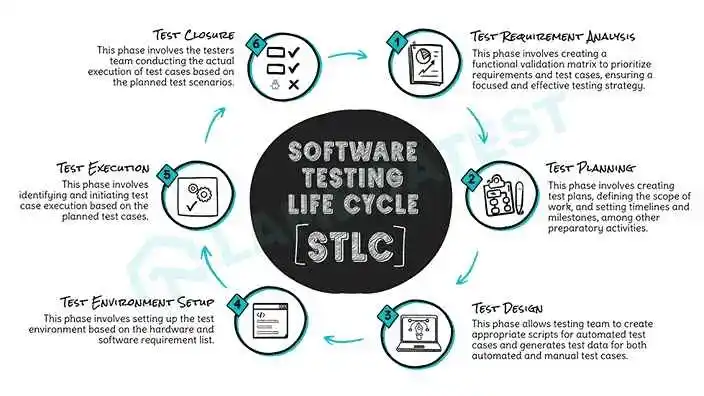
Automated testing uses automation testing tools and frameworks to test cases, compare expected and actual results, and detect defects. It provides efficiency, repeatability, and quick feedback on software quality. Various types of automated testing include:
Unit Testing
- Focus: Test individual components or sections of the code to verify their correct operation.
- Types:
- White Box Testing: Examines the internal structure of the code to identify design flaws through methods like data flow and path testing.
- Gorilla Testing: Repeatedly inputs data to modules to test robustness and fault tolerance, assessing the application’s resilience under stress.
Integration Testing
- Objective: Combines and tests multiple software modules to evaluate overall system operations.
- Methods:
- Big Bang: Tests all modules collectively after full integration.
- Top-Down: Begins with top-level modules, progressively integrating and testing lower modules.
- Bottom-Up: Starts with the lowest-level modules, adding and testing higher-level modules stepwise.
Performance testing
- Purpose: Evaluate whether the software meets performance criteria like speed and load capacity.
- Types:
- Load Testing: Assesses stability under expected user loads.
- Stress Testing: Determines performance under extreme conditions.
- Scalability Testing: Tests the application’s capacity to handle loads beyond its design.
- Flood Testing: Checks database stability and response by transferring large data sets.
- Endurance Testing: Ensures the application can sustain an average load over an extended period.
Security Testing
- Goal: Identify software risks, threats, and vulnerabilities to prevent attacks.
- Types:
- Penetration Testing: Simulates authorized attacks to find security weaknesses.
- Vulnerability Scanning: Automated software is used to scan for known vulnerabilities.
- Security Auditing: Internally inspects applications and systems for security flaws.
- Ethical Hacking: Deliberately hacks the system to uncover vulnerabilities.
- Portability Testing: Evaluates software performance across different environments and system configurations.
Automated testing offers benefits like faster test execution, managing large test suites, and repeatability, making it ideal for tasks like regression testing and comprehensive test coverage. Combining manual and automated testing allows quality assurance teams to thoroughly check software, find problems, and ensure quality and reliability.
A recent poll by LambdaTest on social media has further underscored the value of automation in software development, revealing that the most significant benefit users experience is a "Faster Feedback Loop." This rapid feedback is crucial for agile development environments, where quick adjustments and iterative improvements are essential to the project's success.

Now that we are aware of the types of testing, let us look into the tools that can help us maintain the quality when performing testing, and that makes the tester's life easy.
Tools Required for Software Quality Assurance Testing
Software development teams use quality assurance testing tools to guarantee that their releases align with project requirements, provide an excellent user experience, and have minimal bugs and defects.
Web Automation
- LambdaTest: LambdaTest is an AI-powered testing platform that supports manual and automated tests across over 3000 real devices, browsers, and OS combinations. This platform simplifies QA testing on diverse browsers and systems, enhancing efficiency by automating repetitive tasks and conserving time and resources. To begin your automation testing with LambdaTest, watch this video tutorial to discover how to streamline your testing process easily.
- Selenium: A robust open-source tool for automating browsers, supporting various programming languages and browser types.
App Automation
- LambdaTest: LambdaTest offers robust support for app automation frameworks including Appium, XCUITest, and Espresso. Supports automated mobile app testing, offering access to real devices for accurate testing results.
- Appium: An open-source tool for automating mobile applications, applicable to both Android and iOS platforms.
API Testing
- Postman: User-friendly for automating API testing, with features for creating, sharing, testing APIs, and viewing responses.
- Swagger: Open-source software used for designing, building, and testing APIs.
Performance Testing
- HyperExecute: Run your performance tests on HyperExecute. Have full control on load generation & distribution from multiple regions across the globe.
- LoadRunner: A paid tool known for its advanced features in performance testing, widely used for its comprehensive testing capabilities.
- JMeter: An open-source tool for performance testing and load testing, suitable for analyzing and measuring the performance of a variety of services.
Responsive Testing
- LT Browser: The LT Browser is ideal for developers, allowing simultaneous responsiveness testing on up to six devices. It offers a wide selection of device resolutions and configurations, enhancing responsive development.
Accessibility Testing
- Accessibility DevTools Chrome Extension Powered by Axe DevTools - Ensure website accessibility with Accessibility DevTools Chrome extension. Easily test, manage, and report accessibility issues. Add to Chrome Now for free!
End-to-End (E2E) Testing
- LambdaTest: Facilitates E2E testing by providing a scalable cloud infrastructure for running tests on multiple browsers and devices.
- Cypress: An open-source, front-end testing tool built for the modern web, ideal for E2E testing due to its simplicity and rich feature set.
Check out this detailed blog 20 Best Software Testing Tools for QA covering
Bug Tracking and Defect Management in Software Quality Assurance
Bug Tracking and Defect Management are crucial components of Software Quality Assurance (SQA) that help ensure the delivery of high-quality software products. In this process, bugs or defects found during software development or testing are recorded, tracked, and managed to ensure their timely resolution. Here are some key points to explain these concepts in a professional manner:
Bug Tracking:
- Systematic process of capturing, organizing, and monitoring bugs or defects in software.
- Bugs categorized by severity, priority, etc., aiding effective resolution.
- Managed through bug tracking systems like JIRA, Bugzilla, Trello.
Defect Management:
- Entire process of identifying, reporting, analyzing, and resolving defects.
- Documented with details like steps to reproduce and assigned to team members.
- Monitored for resolution within defined timelines.
Importance of Bug Tracking and Defect Management:
- Facilitates communication among stakeholders, enhancing collaboration.
- Centralized repository for tracking status and resolution.
- Ensures smooth development cycles and timely product releases.
- Improves software quality, user satisfaction, and reduces post-release issues.
Best Practices:
- Define processes clearly in quality assurance plans or SDLC.
- Establish standard taxonomy for categorization.
- Capture detailed bug information, assigned to appropriate team members.
- Conduct regular bug triage meetings to prioritize effectively.
- Utilize automation tools to streamline processes and improve efficiency.
What are the Best Practices for Software Quality Assurance?
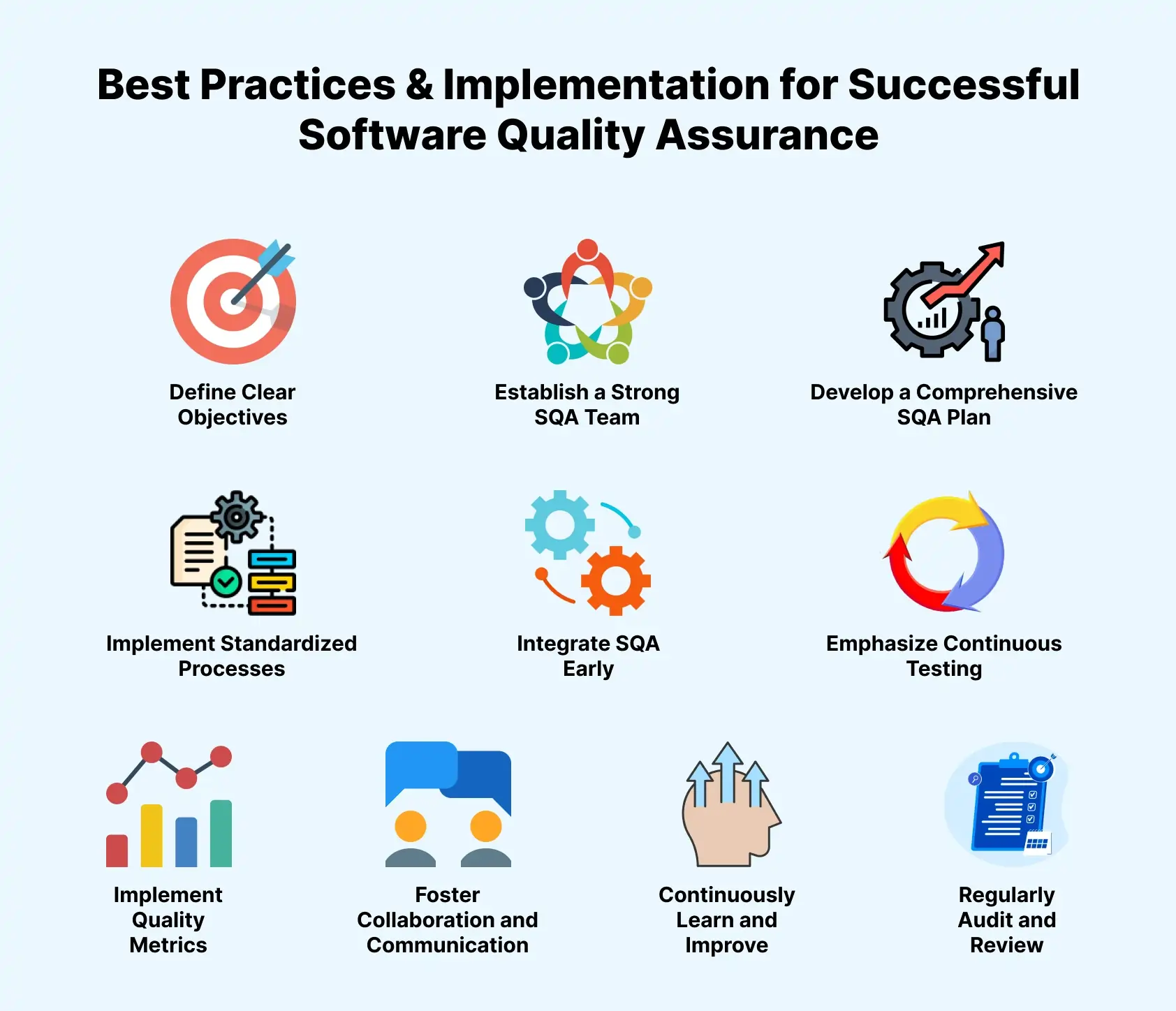
Successfully implementing SQA is crucial for delivering high-quality software products. Here are key practices for an effective SQA implementation:
- Define Clear Objectives: Start by clearly defining the goals of your SQA efforts, such as enhancing software quality, reducing defects, and improving customer satisfaction.
- Establish a Strong SQA Team: Form a dedicated team of professionals with expertise in SQA, software development processes, and testing methodologies. Ensure ongoing training and collaboration.
- Develop a Comprehensive SQA Plan: Outline the necessary SQA activities, timelines, and resources. Include risk assessment, test planning, execution, defect tracking, and reporting. Align this plan with the broader software development lifecycle.
- Implement Standardized Processes: Standardize SQA processes to ensure consistency and efficiency across the organization. Clearly document and communicate these processes, detailing roles, responsibilities, and procedures for defect management.
- Integrate SQA Early: Incorporate SQA from the beginning of the software development lifecycle. Engage SQA in requirement gathering, design reviews, and code inspections to catch and resolve issues early, minimizing rework.
- Emphasize Continuous Testing: Use continuous testing to assess software quality at every stage of development. Employ automated testing tools to enhance efficiency and coverage, and keep test cases updated with changing requirements.
- Implement Quality Metrics: Monitor key quality metrics like defect density, test coverage, and customer satisfaction to evaluate SQA effectiveness and identify improvement opportunities.
- Foster Collaboration and Communication: Promote open communication and collaboration among development, testing, and business teams. Maintain transparency with regular updates on SQA progress and findings.
- Continuously Learn and Improve: Encourage a culture of continuous learning and improvement within the SQA team. Conduct regular retrospectives to glean lessons and refine processes.
- Regularly Audit and Review: Periodically audit and review the SQA processes to ensure adherence to quality standards and identify areas for improvement.
By following these guidelines, organizations can build a robust SQA framework that significantly enhances software quality, boosts customer satisfaction, and strengthens market competitiveness.
Future of Software Quality Assurance
Here are some future trends in software quality assurance (SQA):
- Automation and AI: Automation continues to be a cornerstone of SQA. However, the integration of Artificial Intelligence (AI) and Machine Learning (ML) is revolutionizing how tests are designed, executed, and analyzed. AI-driven testing tools can identify patterns, predict defects, and optimize test coverage more efficiently.
- Agile and DevOps: Popular methodologies emphasizing collaboration and faster releases, with SQA adapting for seamless integration and continuous improvement.
- DevSecOps: DevSecOps integrates security practices within the DevOps process, with SQA teams ensuring security is a priority at every phase.
- Performance Engineering: Focuses on meeting performance requirements throughout the development lifecycle, moving beyond traditional performance testing.
- Shift-Left and Shift-Right Testing: Early testing involving developers for faster defect resolution, and testing in production for real-time user feedback and ongoing quality improvement.
- Data-Driven Testing: With the proliferation of big data and analytics, SQA is leveraging data-driven testing approaches. Test data management, predictive analytics, and AI-driven insights are enhancing the effectiveness and efficiency of testing processes.
- Digital Transformation: As organizations undergo digital transformation, SQA must adapt to the complexities of modern architectures such as microservices, containers, and serverless computing. Testing strategies need to encompass the entire ecosystem to ensure interoperability, security, and performance.
- Security Testing: Integrating Security Testing to identify vulnerabilities and ensure software system confidentiality, integrity, and availability.
- IoT Testing: Validating interoperability, reliability, and performance across IoT devices, networks, and protocols, with specialized testing frameworks being developed.
- Cloud-Based Testing: Offers scalability, flexibility, and cost-effectiveness, enabling real-world scenario simulation and access to various devices and configurations.
Watch the video "Sneak Peek on Future of Quality Assurance Survey" to gain insights based on survey data. The video will provide a glimpse into the future of quality assurance and highlight key trends shaping the industry.
For more insights and tutorials on using LambdaTest for automation testing, visit and subscribe to the LambdaTest YouTube Channel .
Conclusion
Software Quality Assurance (SQA) refers to the final assessment and determination of the quality of a software product or system. It involves analyzing the outcomes of various testing activities, metrics, and quality control processes to make informed decisions regarding the software's readiness for release or deployment. The conclusion phase is crucial as it aims to evaluate whether the software meets the specified requirements, adheres to industry standards, and satisfies end-user expectations.
It involves summarizing the findings, identifying any unresolved issues, and providing recommendations for improvement. This phase ensures that the software is of high quality, reliable, and ready for successful implementation, ultimately contributing to customer satisfaction and business success.
Happy testing!

2M+ Devs and QAs rely on LambdaTest
Deliver immersive digital experiences with Next-Generation Mobile Apps and Cross Browser Testing Cloud
On this page
- What is Quality Assurance Software Testing
- What Does Software Quality Assurance (SQA) Encompasses
- Why is Software Quality Assurance Important?
- How to Implement Software Quality Assurance?
- Types of Software Quality Assurance Testing
- Tools Required for Software Quality Assurance Testing
- Bug Tracking and Defect Management
- Best Practices for Software Quality Assurance?
- Future of Software Quality Assurance
- Frequently Asked Questions (FAQs)
Frequently asked questions
- General
Did you find this page helpful?
More Hubs
Try LambdaTest Now !!
Get 100 minutes of automation test minutes FREE!!



